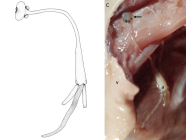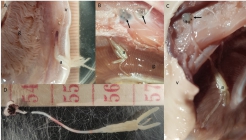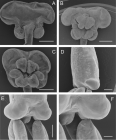WoRMS taxon details
Tripaphylus squidwardi Boxshall, Barton, Kirke, Zhu & Johnson, 2022
1594406 (urn:lsid:marinespecies.org:taxname:1594406)
accepted
Species
marine, brackish, fresh
Boxshall, G.A., D.P. Barton, A. Kirke, X. Zhu & G. Johnson. (2022). Two new parasitic copepods of the family Sphyriidae (Copepoda: Siphonostomatoida) from Australian elasmobranchs. <em>Systematic Parasitology.</em> 99(6): 659-669., available online at https://doi.org/10.1007/s11230-022-10054-4 [details] 
Holotype NTMAG Cr019479, geounit Australian Exclusive...
, Note Holotype female, intact with one missing egg...
Holotype NTMAG Cr019479, geounit Australian Exclusive Economic Zone [details]
From editor or global species database
Type material Holotype female, intact with one missing egg sac, from Carcharhinus coatesi Whitley, 1939 (CARCOA 400, collected 27 Nov 2018; -10.23, 134.65; Male 694 mm TL), MAGNT Registration Number NTM Cr019479; paratype intact female and 2 headless paratype females from same host (CARCOA 400), NTM Cr0179480; paratype female intact but lacking egg sacs, from C. coatesi (CARCOA 140, collected 14 May 2019; -10.266, 136.3096; Male 772 mm TL), NTM Cr0179481; paratype female intact but lacking egg sacs, from C. coatesi (CARCOA 145, collected 14 May 2019; -10.266, 136.3096; Female 793 mm TL), NTM Cr0179482; 2 paratype females intact and bearing egg sacs, from C. coatesi (CARCOA 210, collected 20 Nov 2018; -10.17, 134.65; Male 674 mm TL), NTM Cr0179483; 4 paratype females intact, 3 bearing egg sacs, and 3 incomplete paratype females from C. coatesi (CARCOA 632, collected 06 Jun 2019; -8.25, 129.15; Male 645 mm TL), NTM Cr0179484; paratype female intact with egg sacs, from C. coatesi (CARCOA 633, collected 06 Jun 2019; -8.25, 129.15; Female 633 mm TL), NTM Cr0179485; paratype female intact with egg sacs, from C. coatesi (CARCOA 664, collected 27 Nov 2018; - 10.23, 134.65; Male 673 mm TL), NTM Cr0179486; headless paratype female, trunk bearing paired egg sacs, from C. coatesi (CARCOA 113, collected 01 Dec 2018; -10.70, 128.73; Male 579 mm TL), NTM Cr0179487; headless paratype female, trunk lacking egg sacs, from C. coatesi (CARCOA 136, collected 14 May 2019; -10.266, 136.3096; Female, TL not measured), NTM Cr0179488; 3 headless paratype females, 1 ovigerous and 2 with trunk lacking egg sacs, from C. coatesi (CARCOA 149, collected 29 May 2019; - 12.5243, 128.5889; Female 743 mm TL), NTM Cr0179489; headless paratype female, trunk with broken egg sacs, from C. coatesi (CARCOA 160, collected 28 May 2019; -12.5531, 128.5595; Male 683 mm TL), NTM Cr0179490; headless paratype female, trunk with broken egg sacs, from C. coatesi (CARCOA 275, collected 06 Jun 2019; -8.25, 129.15; Female 736 mm TL), NTM Cr0179491; 2 isolated paratype heads plus 3 headless trunks lacking egg sacs, from C. coatesi (CARCOA 276, collected 06 Nov 2018; -10.28333, 135.6667; Male 741 mm TL), NTM Cr0179492; headless paratype female, trunk lacking egg sacs, from C. coatesi (CARCOA 362, collected 15 Feb 2019; -10.11667, 136.3167; Female 776 mm TL), NTM Cr0179493; headless paratype female, trunk lacking egg sacs, from C. coatesi (CARCOA 415, collected 28 Nov 2018; -10.25, 134.13; Female, 645 mm TL), NTM Cr0179494; headless paratype female, trunk lacking egg sacs, from C. coatesi (CARCOA 660, collected 28 Nov 2018; -10.25, 134.13; Male 716 mm TL), NTM Cr0179495; paratype female with head intact but trunk incomplete, from C. coatesi (CARCOA 670, collected 28 Nov 2018; -10.25, 134.13; Male 731 mm TL), NTM Cr0179496: 4 paratype females intact, 3 bearing egg sacs, and 3 incomplete paratype females from C. coatesi (CARCOA 632, collected 06 Jun 2019; -8.25, 129.15; Male 645 mm TL) NHMUK 2022.174-177. [details]
Description Transformed adult female. Body (Fig. 1A) comprising cephalothorax, neck and trunk incorporating minute abdomen and bearing...
Etymology The shape of the head of this species resembles that of the character Squidward from the cartoon Sponge Bob. The new name,...
Description Transformed adult female. Body (Fig. 1A) comprising cephalothorax, neck and trunk incorporating minute abdomen and bearing large paired posterior processes. Measurements of holotype female: total length measured from frontal margin of cephalothorax to posterior margin of anal prominence (excluding posterior processes) 24.5 mm; cephalothorax length 1.6 mm, width 3.9 mm; neck length about 13.8 mm, trunk length about 9.1 mm [neck ? trunk combined length 22.9 mm], maximum trunk width 2.1 mm; posterior processes length 4.9 mm, width 1.1 mm; egg sac length 14.4 mm. Mean total body length of intact paratypes 25.1 mm, range 22.3 to 27.3 mm (n = 10).
Neck slender, cylindrical with smooth margin; expanded anteriorly at junction with cephalothorax; expanding gradually posteriorly to merge with trunk. Neck always longer than trunk, mean 1.48 times, with a range of 1.02 to 1.90 times longer (n = 11). Trunk about 4.3 times longer than wide, slightly compressed dorsoventrally and increasing in width towards maximum at posterior end; bearing paired lateral swellings near posterior end (Fig. 2D,E). Abdomen (Fig. 2F) incorporated into trunk. Trunk bearing paired posterior processes ventrally; each process cylindrical, blunt tipped, and ranging from 4.5 to 6.9 times longer than wide, with mean of 5.6 times (n = 13). Egg sacs multiseriate, originating from dorsally located oviduct openings near posterior margin of trunk; typically about twice as long as posterior processes, ranging from 1.8 to 2.9 times longer (n = 8).
Cephalothorax bulbous bearing pair of antennary swellings anteriorly on ventral surface (Fig. 1B, as; Fig. 2B, C); frontal margin of antennary swellings typically just visible in dorsal view (Fig. 1A, 2A). Paired posterior swellings on ventral surface of cephalothorax clearly visible in dorsal view (Fig. 1A). Two additional paired swellings present on ventral surface of cephalothorax, between antennary and posterior swellings (Fig. 1B, ps): smaller maxillary swellings (Fig. 1B, ms) and larger ventrolateral swellings (Fig. 1B, vls). Paired maxillary and ventrolateral swellings confluent at base and separated, along ventral midline, by narrow raised central ridge (Fig. 1B, cr).
Antennule cylindrical, indistinctly segmented; setation not observed. Antenna (Fig. 1C) biramous; protopodal part unarmed; exopod unsegmented, bulbous, shorter than endopod; armed with inner and outer setae subapically; ornamented with minute denticles on rounded apex; endopod 2-segmented, proximal segment ornamented with spinules distally; distal margin of terminal segment bearing robust outer hook, 2 stout naked setae, and 1 minute seta; inner extremity of margin slightly inflated and ornamented with minute denticles. Mouth tube not observed clearly. Mandible (Fig. 1D) stylet-like, forming slender blade with 9 marginal teeth increasing in size towards tip. Maxillule (Fig. 1E) slender with 1 small and 2 large setae around apex and 2 small setae on proximally located outer lobe. Maxilla (Fig. 1B, mx) comprising small digitiform process carried posteriorly on maxillary swelling. Maxillipeds located posterior to oral region and anterior to maxillary swellings; subchelate, each with broad protopodal corpus expanded into strongly denticulate myxal process opposing tip of subchela; subchela armed with blunt-tipped seta about midway along inner margin (Fig. 1F).
Male unknown. [details]
Neck slender, cylindrical with smooth margin; expanded anteriorly at junction with cephalothorax; expanding gradually posteriorly to merge with trunk. Neck always longer than trunk, mean 1.48 times, with a range of 1.02 to 1.90 times longer (n = 11). Trunk about 4.3 times longer than wide, slightly compressed dorsoventrally and increasing in width towards maximum at posterior end; bearing paired lateral swellings near posterior end (Fig. 2D,E). Abdomen (Fig. 2F) incorporated into trunk. Trunk bearing paired posterior processes ventrally; each process cylindrical, blunt tipped, and ranging from 4.5 to 6.9 times longer than wide, with mean of 5.6 times (n = 13). Egg sacs multiseriate, originating from dorsally located oviduct openings near posterior margin of trunk; typically about twice as long as posterior processes, ranging from 1.8 to 2.9 times longer (n = 8).
Cephalothorax bulbous bearing pair of antennary swellings anteriorly on ventral surface (Fig. 1B, as; Fig. 2B, C); frontal margin of antennary swellings typically just visible in dorsal view (Fig. 1A, 2A). Paired posterior swellings on ventral surface of cephalothorax clearly visible in dorsal view (Fig. 1A). Two additional paired swellings present on ventral surface of cephalothorax, between antennary and posterior swellings (Fig. 1B, ps): smaller maxillary swellings (Fig. 1B, ms) and larger ventrolateral swellings (Fig. 1B, vls). Paired maxillary and ventrolateral swellings confluent at base and separated, along ventral midline, by narrow raised central ridge (Fig. 1B, cr).
Antennule cylindrical, indistinctly segmented; setation not observed. Antenna (Fig. 1C) biramous; protopodal part unarmed; exopod unsegmented, bulbous, shorter than endopod; armed with inner and outer setae subapically; ornamented with minute denticles on rounded apex; endopod 2-segmented, proximal segment ornamented with spinules distally; distal margin of terminal segment bearing robust outer hook, 2 stout naked setae, and 1 minute seta; inner extremity of margin slightly inflated and ornamented with minute denticles. Mouth tube not observed clearly. Mandible (Fig. 1D) stylet-like, forming slender blade with 9 marginal teeth increasing in size towards tip. Maxillule (Fig. 1E) slender with 1 small and 2 large setae around apex and 2 small setae on proximally located outer lobe. Maxilla (Fig. 1B, mx) comprising small digitiform process carried posteriorly on maxillary swelling. Maxillipeds located posterior to oral region and anterior to maxillary swellings; subchelate, each with broad protopodal corpus expanded into strongly denticulate myxal process opposing tip of subchela; subchela armed with blunt-tipped seta about midway along inner margin (Fig. 1F).
Male unknown. [details]
Etymology The shape of the head of this species resembles that of the character Squidward from the cartoon Sponge Bob. The new name,...
Etymology The shape of the head of this species resembles that of the character Squidward from the cartoon Sponge Bob. The new name, squidwardi, alludes to this resemblance. [details]
Walter, T.C.; Boxshall, G. (2024). World of Copepods Database. Tripaphylus squidwardi Boxshall, Barton, Kirke, Zhu & Johnson, 2022. Accessed through: World Register of Marine Species at: https://www.marinespecies.org/aphia.php?p=taxdetails&id=1594406 on 2024-07-23
![]() The webpage text is licensed under a Creative Commons Attribution 4.0 License
The webpage text is licensed under a Creative Commons Attribution 4.0 License
original description
Boxshall, G.A., D.P. Barton, A. Kirke, X. Zhu & G. Johnson. (2022). Two new parasitic copepods of the family Sphyriidae (Copepoda: Siphonostomatoida) from Australian elasmobranchs. <em>Systematic Parasitology.</em> 99(6): 659-669., available online at https://doi.org/10.1007/s11230-022-10054-4 [details] 
biology source Barton, D.P., A. Kirke, G. Johnson & G. Boxshall. (2022). Pathology associated with Tripaphylus Richiardi, 1878 infection (Copepoda: Sphyriidae) in wild-caught Australian blackspot sharks, Carcharhinus coatesi (Whitley, 1939), off northern Australia. <em>Parasitology Research.</em> 121(11):3337-3340. Sep 2022., available online at https://doi.org/10.1007/s00436-022-07662-w [details] Available for editors [request]
[request]
biology source Barton, D.P., A. Kirke, G. Johnson & G. Boxshall. (2022). Pathology associated with Tripaphylus Richiardi, 1878 infection (Copepoda: Sphyriidae) in wild-caught Australian blackspot sharks, Carcharhinus coatesi (Whitley, 1939), off northern Australia. <em>Parasitology Research.</em> 121(11):3337-3340. Sep 2022., available online at https://doi.org/10.1007/s00436-022-07662-w [details] Available for editors
 Present
Present  Present in aphia/obis/gbif/idigbio
Present in aphia/obis/gbif/idigbio  Inaccurate
Inaccurate  Introduced: alien
Introduced: alien  Containing type locality
Containing type locality
Holotype NTMAG Cr019479, geounit Australian Exclusive Economic Zone [details]
From editor or global species database
Description Transformed adult female. Body (Fig. 1A) comprising cephalothorax, neck and trunk incorporating minute abdomen and bearing large paired posterior processes. Measurements of holotype female: total length measured from frontal margin of cephalothorax to posterior margin of anal prominence (excluding posterior processes) 24.5 mm; cephalothorax length 1.6 mm, width 3.9 mm; neck length about 13.8 mm, trunk length about 9.1 mm [neck ? trunk combined length 22.9 mm], maximum trunk width 2.1 mm; posterior processes length 4.9 mm, width 1.1 mm; egg sac length 14.4 mm. Mean total body length of intact paratypes 25.1 mm, range 22.3 to 27.3 mm (n = 10).Neck slender, cylindrical with smooth margin; expanded anteriorly at junction with cephalothorax; expanding gradually posteriorly to merge with trunk. Neck always longer than trunk, mean 1.48 times, with a range of 1.02 to 1.90 times longer (n = 11). Trunk about 4.3 times longer than wide, slightly compressed dorsoventrally and increasing in width towards maximum at posterior end; bearing paired lateral swellings near posterior end (Fig. 2D,E). Abdomen (Fig. 2F) incorporated into trunk. Trunk bearing paired posterior processes ventrally; each process cylindrical, blunt tipped, and ranging from 4.5 to 6.9 times longer than wide, with mean of 5.6 times (n = 13). Egg sacs multiseriate, originating from dorsally located oviduct openings near posterior margin of trunk; typically about twice as long as posterior processes, ranging from 1.8 to 2.9 times longer (n = 8).
Cephalothorax bulbous bearing pair of antennary swellings anteriorly on ventral surface (Fig. 1B, as; Fig. 2B, C); frontal margin of antennary swellings typically just visible in dorsal view (Fig. 1A, 2A). Paired posterior swellings on ventral surface of cephalothorax clearly visible in dorsal view (Fig. 1A). Two additional paired swellings present on ventral surface of cephalothorax, between antennary and posterior swellings (Fig. 1B, ps): smaller maxillary swellings (Fig. 1B, ms) and larger ventrolateral swellings (Fig. 1B, vls). Paired maxillary and ventrolateral swellings confluent at base and separated, along ventral midline, by narrow raised central ridge (Fig. 1B, cr).
Antennule cylindrical, indistinctly segmented; setation not observed. Antenna (Fig. 1C) biramous; protopodal part unarmed; exopod unsegmented, bulbous, shorter than endopod; armed with inner and outer setae subapically; ornamented with minute denticles on rounded apex; endopod 2-segmented, proximal segment ornamented with spinules distally; distal margin of terminal segment bearing robust outer hook, 2 stout naked setae, and 1 minute seta; inner extremity of margin slightly inflated and ornamented with minute denticles. Mouth tube not observed clearly. Mandible (Fig. 1D) stylet-like, forming slender blade with 9 marginal teeth increasing in size towards tip. Maxillule (Fig. 1E) slender with 1 small and 2 large setae around apex and 2 small setae on proximally located outer lobe. Maxilla (Fig. 1B, mx) comprising small digitiform process carried posteriorly on maxillary swelling. Maxillipeds located posterior to oral region and anterior to maxillary swellings; subchelate, each with broad protopodal corpus expanded into strongly denticulate myxal process opposing tip of subchela; subchela armed with blunt-tipped seta about midway along inner margin (Fig. 1F).
Male unknown. [details]
Etymology The shape of the head of this species resembles that of the character Squidward from the cartoon Sponge Bob. The new name, squidwardi, alludes to this resemblance. [details]
Type material Holotype female, intact with one missing egg sac, from Carcharhinus coatesi Whitley, 1939 (CARCOA 400, collected 27 Nov 2018; -10.23, 134.65; Male 694 mm TL), MAGNT Registration Number NTM Cr019479; paratype intact female and 2 headless paratype females from same host (CARCOA 400), NTM Cr0179480; paratype female intact but lacking egg sacs, from C. coatesi (CARCOA 140, collected 14 May 2019; -10.266, 136.3096; Male 772 mm TL), NTM Cr0179481; paratype female intact but lacking egg sacs, from C. coatesi (CARCOA 145, collected 14 May 2019; -10.266, 136.3096; Female 793 mm TL), NTM Cr0179482; 2 paratype females intact and bearing egg sacs, from C. coatesi (CARCOA 210, collected 20 Nov 2018; -10.17, 134.65; Male 674 mm TL), NTM Cr0179483; 4 paratype females intact, 3 bearing egg sacs, and 3 incomplete paratype females from C. coatesi (CARCOA 632, collected 06 Jun 2019; -8.25, 129.15; Male 645 mm TL), NTM Cr0179484; paratype female intact with egg sacs, from C. coatesi (CARCOA 633, collected 06 Jun 2019; -8.25, 129.15; Female 633 mm TL), NTM Cr0179485; paratype female intact with egg sacs, from C. coatesi (CARCOA 664, collected 27 Nov 2018; - 10.23, 134.65; Male 673 mm TL), NTM Cr0179486; headless paratype female, trunk bearing paired egg sacs, from C. coatesi (CARCOA 113, collected 01 Dec 2018; -10.70, 128.73; Male 579 mm TL), NTM Cr0179487; headless paratype female, trunk lacking egg sacs, from C. coatesi (CARCOA 136, collected 14 May 2019; -10.266, 136.3096; Female, TL not measured), NTM Cr0179488; 3 headless paratype females, 1 ovigerous and 2 with trunk lacking egg sacs, from C. coatesi (CARCOA 149, collected 29 May 2019; - 12.5243, 128.5889; Female 743 mm TL), NTM Cr0179489; headless paratype female, trunk with broken egg sacs, from C. coatesi (CARCOA 160, collected 28 May 2019; -12.5531, 128.5595; Male 683 mm TL), NTM Cr0179490; headless paratype female, trunk with broken egg sacs, from C. coatesi (CARCOA 275, collected 06 Jun 2019; -8.25, 129.15; Female 736 mm TL), NTM Cr0179491; 2 isolated paratype heads plus 3 headless trunks lacking egg sacs, from C. coatesi (CARCOA 276, collected 06 Nov 2018; -10.28333, 135.6667; Male 741 mm TL), NTM Cr0179492; headless paratype female, trunk lacking egg sacs, from C. coatesi (CARCOA 362, collected 15 Feb 2019; -10.11667, 136.3167; Female 776 mm TL), NTM Cr0179493; headless paratype female, trunk lacking egg sacs, from C. coatesi (CARCOA 415, collected 28 Nov 2018; -10.25, 134.13; Female, 645 mm TL), NTM Cr0179494; headless paratype female, trunk lacking egg sacs, from C. coatesi (CARCOA 660, collected 28 Nov 2018; -10.25, 134.13; Male 716 mm TL), NTM Cr0179495; paratype female with head intact but trunk incomplete, from C. coatesi (CARCOA 670, collected 28 Nov 2018; -10.25, 134.13; Male 731 mm TL), NTM Cr0179496: 4 paratype females intact, 3 bearing egg sacs, and 3 incomplete paratype females from C. coatesi (CARCOA 632, collected 06 Jun 2019; -8.25, 129.15; Male 645 mm TL) NHMUK 2022.174-177. [details]




